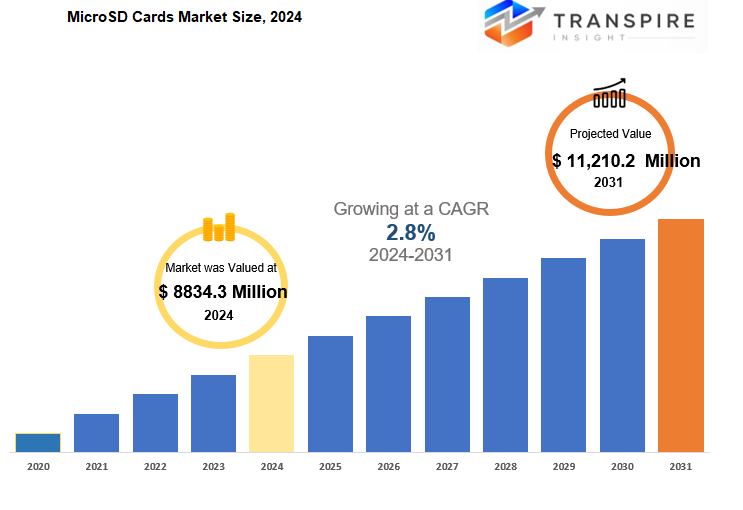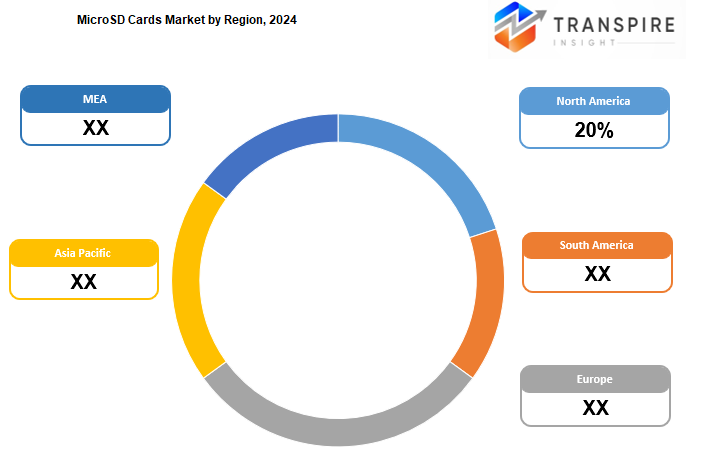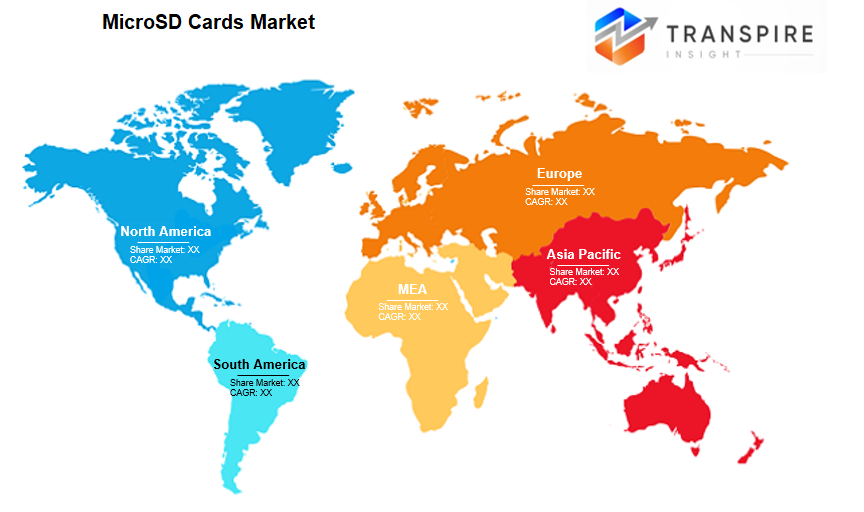MARKET OVERVIEW:
Global MicroSD Cards market is estimated to reach $11,210.2 Million by 2031; growing at a CAGR of 2.8% from 2024 to 2031.
The global market for MicroSD Cards is a significant part of the electronics industry, offering compact and high-capacity storage solutions for a variety of devices. MicroSD cards are expected to continue to be popular due to their small size and versatility, being used in smartphones, tablets, cameras, and IoT devices.
These cards are projected to evolve to meet the increasing demand for higher storage capacity and faster data transfer rates, ensuring excellent performance and reliability. Future developments may include increased storage capacities, faster speeds, and enhanced security features to cater to emerging technologies and consumer trends. As consumer demand for high-resolution cameras and mobile devices grows, the need for larger storage capacities will also increase, prompting manufacturers to invest in research and development.
The expansion of smart technology applications will also benefit the microSD card market, as these devices generate more data that requires reliable storage solutions. Another growth driver will be the focus on data security, with manufacturers likely to embed advanced encryption and security techniques in microSD cards to protect user information.
Emerging markets are expected to contribute significantly to the growth of the global microSD card market as they continue to develop technologically. With continuous innovation, including improved storage capacity, increased speed, and enhanced security, microSD cards are expected to remain relevant in the ever-evolving electronics industry to meet the growing demand for efficient data management solutions.

GROWTH FACTORS
The Global MicroSD Cards market is growing due to increased demand from mobile devices requiring higher storage capacity. Improvements in transfer speed and storage capacity are driving the market, as people seek faster access to data. However, challenges like the popularity of cloud storage and concerns over data security could hinder market expansion.
On a positive note, the rise of IoT devices and smart gadgets presents opportunities for MicroSD cards, as they offer flexible and effective storage solutions. Manufacturers are focusing on enhancing data transfer speeds and security features to meet changing consumer needs. As the market evolves, the ability to adapt to new technologies and applications will be crucial for its success in the future.

MARKET SEGMENTATION
By Type
The Global MicroSD Cards market is evolving as technology advances. These small cards are essential to expand the memory of smartphones, tablets, cameras, and other devices. The market is segmented into SD, SDHC, and SDXC types, allowing consumers to choose based on usage and capacity needs. SD cards offer small storage capacity, suitable for basic functions on devices with low storage requirements. SDHC cards provide 2 to 32 gigabytes of storage, striking a balance between capacity and cost, making them popular. Meanwhile, SDXC cards offer storage capacities ranging from 32 gigabytes to 400 gigabytes, catering to those needing large storage for high-resolution videos and data. These cards will continue to grow in demand, especially with the rise in 4K and 8K video recording.
The future of MicroSD cards will likely see improvements in read and write speeds to facilitate dealing with large files, as well as enhancements in durability like water resistance and temperature tolerance. Manufacturers are expected to innovate to make the cards more user-friendly and functional. With evolving consumer needs and technological advancements, the market will continue to expand and transform. MicroSD cards will remain relevant in the digital storage world, offering specific advantages to different users. The market growth will be driven by innovation and consumer-oriented improvements, catering to the increasingly digital future.
By Application
The Global MicroSD Cards market is projected to experience significant growth due to technological advancements and the rising demand for portable storage options. MicroSD cards are crucial in various applications because of their small size and high storage capacity, and as technology progresses, their use will expand to serve a wide range of devices and purposes.
The future demand for MicroSD cards will be driven by smartphone users needing additional storage capacity for high-resolution cameras and advanced gaming. These cards enable users to expand their smartphone's storage without compromising performance, allowing them to store more photos, videos, and apps, enhancing the overall smartphone experience.
Tablet PCs are also expected to contribute to the growth of the Global MicroSD Cards market as they gain popularity for both personal and professional use. Businesses are increasingly using tablets for mobile solutions, while consumers use them for entertainment and productivity, leading to a rise in demand for expandable storage options like MicroSD cards.
Furthermore, the demand for MicroSD cards in digital cameras is expected to increase with evolving camera technologies requiring advanced storage solutions for high-resolution images and videos. Additionally, the gaming console market will drive demand for MicroSD cards as portable gaming consoles and mobile gaming become more prevalent, necessitating additional storage for large game files and updates.
Overall, the Global MicroSD Cards market shows promising growth potential, with opportunities for expansion into new areas driven by technological advancements and consumer demand for enhanced storage solutions. MicroSD cards are set to become a vital component in the tech ecosystem, catering to user needs through innovative solutions that enhance the digital experience.
REGIONAL ANALYSIS
The Global MicroSD Cards market is set to undergo significant changes due to technological advancements driving demand and competition. In North America, the increasing adoption of smartphones and tablets will be a major driver of market growth, with countries like the US, Canada, and Mexico being key players. The demand for high-capacity storage solutions is increasing due to digitalization, the rise of high-definition video recording, and gaming applications.
In Europe, countries like the UK, Germany, France, and Italy will contribute to market growth as people seek reliable storage options for preserving memories with the increased adoption of digital cameras and electronic devices. The gaming sector and multi-device use for entertainment purposes will also fuel demand in the region. Data security awareness among European customers is also pushing manufacturers to enhance security features in their MicroSD cards.
Asia-Pacific, led by countries like China, India, Japan, and South Korea, will dominate the Global MicroSD Cards market. The growth in this region will be driven by increasing smartphone penetration and e-commerce expansion as more consumers go online to access internet and digital content. South America, particularly Brazil and Argentina, will also see a rise in demand for storage solutions due to increased mobile phone and electronic gadget usage. The Middle East & Africa, including GCC countries, Egypt, and South Africa, will also experience growth due to rising smartphone penetration and digital content consumption.
Overall, the Global MicroSD Cards market is expected to grow dynamically across various regions with manufacturers needing to focus on innovation and quality to meet changing consumer demand. There will also be a shift towards more advanced products with enhanced security features and larger capacities to cater to the increasing demand for digital storage solutions worldwide.

KEY INDUSTRY PLAYERS
The rise in technology has increased consumer demand for MicroSD Cards globally. Key players like SanDisk, Transcend Information, ADATA Technologies, Panasonic, and Kingston Technology have been pivotal in shaping the market.
SanDisk focuses on high-capacity and high-speed cards while Transcend offers rugged and reliable storage devices. ADATA Technologies emphasizes advanced products and enhancing data transfer speeds. Panasonic and Kingston Technology provide versatile, high-performance MicroSD cards. Micron Technology and Sony collaborate to boost their market presence.
Companies like Samsung Electronics, Toshiba, and PNY Technologies are developing MicroSD cards with enhanced security features and increased storage capacity. Lexar, Patriot Memory, and Integral Memory focus on affordability and efficiency to capture budget-conscious customers. Verbatim, Team Group, and Silicon Power offer fast, reliable MicroSD cards. Gigastone, Apacer, KIOXIA, Netac, V7, and Goodram are continuously improving MicroSD card technology through research and development.
The growth of the Global MicroSD Cards market will be driven by performance, storage capacity, and compatibility. These competitive players will play a crucial role as technology evolves and sets the path for the future of data storage solutions.
REPORT SCOPE AND SEGMENTATION
|
Attributes |
Details |
|
Market Size By 2031 |
USD 11,210.2 Million |
|
Growth Rate |
CAGR of 2.8% |
|
Forecast period |
2024 - 2031 |
|
Report Pages |
250+ |
|
By Type |
|
|
By Application |
|
|
By Region |
|
|
Key Market Players |
|



_page-000127.jpg)
_page-000131.jpg)
_page-000130.jpg)
_page-000129.jpg)
_page-000128.jpg)

1.jpg)




 APAC:+91 7666513636
APAC:+91 7666513636





